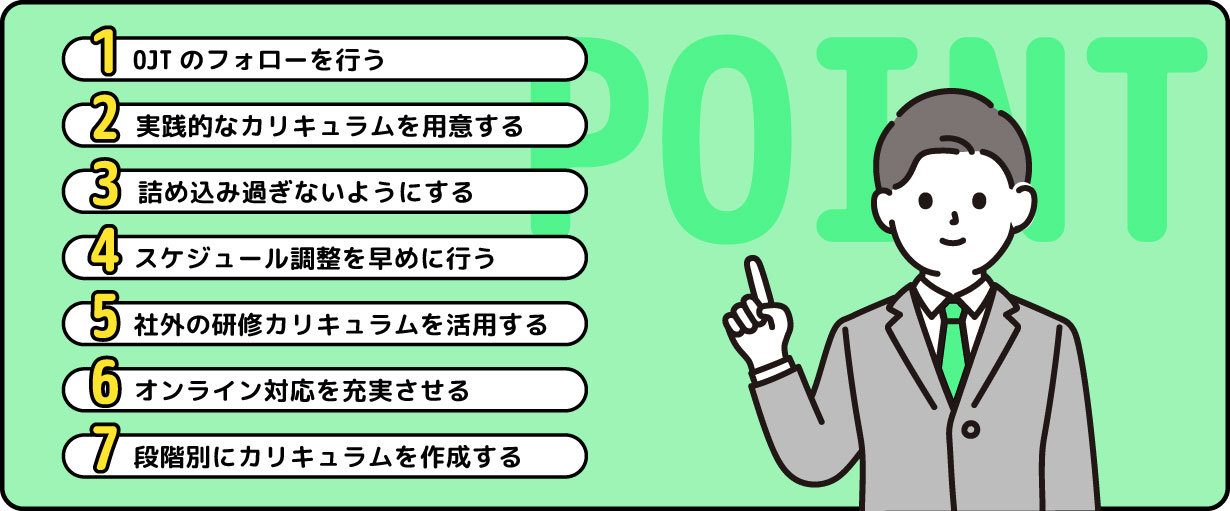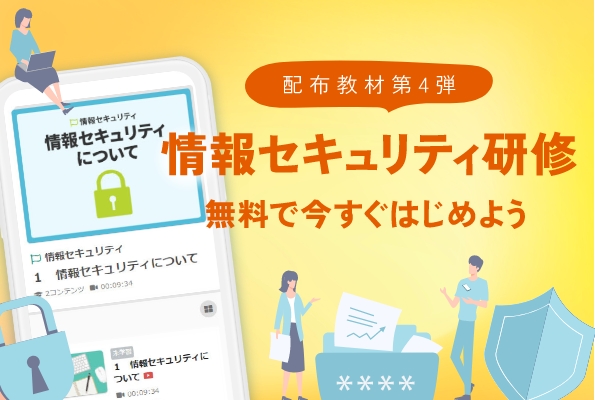Seven points for creating a training curriculum for new employees
Seven points for creating a training curriculum for new employees
When training new employees, it is important to create a curriculum.
Careful preparation is required to get the full effect.
But.I don't know where to start." "What kind of training should I give to new employees?"I know that there are many people who are confused and do not know what to do.
If you don't carefully examine the content of the curriculum, you will end up with the same "usual new employee training" no matter who does it.
Therefore, this article will provide a point-by-point explanation of the basic approach to new employee training and how to create a curriculum.
Content
- 1.How to conduct basic training for new employees
- 2.7 points to consider when creating a training curriculum for new employees
- 3. Content to be incorporated in training for new employees
- 4. Summary
How to conduct basic training for new employees

Here is a basic outline of how to conduct training for new employees.
Understand the skills of new hires.
New employee training begins with an understanding of the new employee's skills.
Administrative skills, PC skills, and communication skills vary from employee to employee.
Understand the skills that the new employee has and include the necessary training content as appropriate.
Individual skills can be checked by checking the resumes submitted for selection, as well as through aptitude tests and personality assessments.
Ask each department what skills they are looking for.
Hear in advance what abilities each department is looking for.
If you know what skills are actually required in the field, you will know what to do in the training.
Coaching is also smoother for instructors after they are assigned to OJT.
Interview new hires from the previous year.
Interview new hires from the previous year as well as the department.
Feedback from employees who have already been through the training will be useful for the next round of training for new employees.
They may say, "The initial ice-breaker made it easier to exchange opinions," or "The case study was useful in the real world.
Positive feedback should be implemented in the next training session.
Also, anonymous questionnaires can be used to identify areas for improvement, such as "I wish there was more specialized learning" or "I wish there was more training period.
Define goals and objectives.
New employee training should have clear goals and objectives.
Training without goals makes it difficult to evaluate each individual and lowers the motivation of the employees receiving the training.
It is important to set goals and objectives while including in the items what you want the new employee to learn.
Reflecting on the training
It is also important to look back on the new employee training after it has been conducted.
If you do this in multiple sessions, check your progress to the goal at each completion.
If things are not going according to plan, you can change course by extending the training period or changing the content of implementation.
Also, if you look back and see the effects in detail, it will be useful for the next year's new employee training.
7 points to consider when creating a training curriculum for new employees

After knowing how to conduct training for new employees, it is important to create a specific curriculum.
Here are seven points to consider when creating a curriculum.
[Point 1] Follow up with OJT.
You may have the image that OJT is one-on-one between the on-site supervisor and the new employee, but human resources should also take an active role in the process.
Conducting regular interviews with both supervisors and new hires will increase the quality of OJT and make it highly effective.
Also, if OJT instruction is made an evaluation item, it will lead to increased motivation on the part of the instructors.
[Point 2] Prepare a practical curriculum.
In addition to classroom lectures, prepare a more practical curriculum. Role-playing is the best choice for practical training.
Role-playing, as used in training, refers to assigning the role of a salesperson and the role of a customer and learning how to exchange business cards and answer the phone.
If they can simulate the actual work, they will take the training with a sense of personal responsibility.
[Point 3] Don't pack too much.
Be selective about the content of your new employee training, and be careful not to cram too much into it.
There is a lot to remember and it is easy to include a lot of content, but the new employee may not be able to keep up with the understanding.
If the curriculum is unavoidably large, try to adjust it by making it a longer training program or conducting follow-up training at a later date.
[Point 4] Adjust your schedule as soon as possible.
Adjust your schedule as early as possible when planning your curriculum.
This is because creating a curriculum takes a great deal of time, from planning to setting up instructors and understanding their skills.
Depending on the size of the training program and other factors, it is best to allow three months, and start preparing for new employee training around December of the previous year.
Point 5] Use external training curriculum
If preparation is difficult, try using an outside training curriculum. If you outsource the training to a third party, you will have the advantage of saving preparation time.
Outside training programs are available to help new employees improve their skills, such as training in logical thinking, time management training, and those that focus on specific industries.
[Point 6] Enhance online support.
Online support is also useful when creating a training curriculum. With online support, the number of participants is not limited, and the quality is evenly distributed.
It also has the advantage of cost, since there are no venue or transportation costs as in group training.
The addition of e-learning is even more effective. It makes it easier to acquire knowledge and skills as you can study anywhere, without being restricted by location or time.
However, it is difficult to communicate as well as face-to-face, so use a good combination of online and offline communication as needed.
Point 7] Create a step-by-step curriculum.
If you create a curriculum with the following three steps in mind, the setup will be smooth.
Pre-employment training
Initial training
OJT in the department
At each stage, look back on the training and clarify "what effects were obtained" and "what points should be passed on to the next stage".
If HR does not have a grasp of this, there will be a discrepancy between the training and the expectations of new employees, and the training will not be fully effective.
Content to be incorporated in training for new employees
Let's take a look at what exactly you should include in your new employee training.
Mindset Training
The first thing I want to incorporate is"Mindset Training.", will be one of the solutions for employees both at home and abroad.
Mindset is to instill in them "what is the difference between being a student and being a member of society" and "what they should be aware of as a member of society".
If they are aware of being a member of society from the beginning, it will be easier for them to accept the training that follows.
Business manner training
Business manner training" is a training program that teaches skills useful in various business situations.
From grooming to make a good impression, to the proper way to hand out business cards, to emailing, etc., all of these require careful and time-consuming training.
Business etiquette can be highly effective by introducing role-plays and case studies that provide more practical learning.
Communication skills training
Communication skills training is effective for industries where there is a lot of interaction with people, such as sales and customer service.
Group work is a good way to learn and appreciate the importance of working as a team.
It also gives you a chance to talk with various peers in the company, strengthening horizontal ties.
Training to deepen understanding of business operations
Don't forget to include training where you can learn about the business.
Create a curriculum that allows you to understand not only what kind of services and goods your company provides, but also how it earns revenue and its business model.
Learning more about the company will motivate you to believe that the training you are receiving is necessary.
Training on professional skills and knowledge
In addition to basic training, provide training for specialized skills and knowledge.
By including them in the early stages of training, you can create new employees who can play an active role in the early stages.
Summary
We introduced how to conduct training for new employees and the key points for creating a curriculum.
Once a new employee has a solid foundation in business and understands the company, he or she can be expected to be an immediate asset.
Rather than throwing the whole thing at the leaders, let's have HR step in and support the whole organization.
If it is difficult to adjust your schedule, we recommend that you consider outside instructors or online support.
Now that remote is becoming the norm, combining traditional training with e-learning can help motivate new employees.
Our e-learning system "learningBOX" is sure to help you improve the efficiency of your new employee training and online learning.
First of all, it's free. Free Planand we hope you will consider introducing it.
Also recommended! Also read: "[Free e-learning trial] LearningBOX is available for individual use.

- How to create an effective plan for human resource development
- Great effects of in-house training on small and mid-size enterprises
Comment ( 0 )
Trackbacks are closed.








No comments yet.